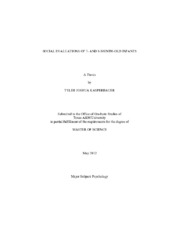| dc.description.abstract | A landmark experiment by Kiley Hamlin, Karen Wynn, and Paul Bloom demonstrated that infants as young as 6 months old possess previously unrecognized abilities to form social evaluations. In the experiment, infants were shown a shape that was made to appear as if it was climbing a hill. In one event, another shape helped the climber up the hill, while in a separate event, a different shape prevented the climber from reaching the top. When offered a choice between the helping and hindering shapes, both 6- and 10-month-olds chose the helping shape over the hindering shape, showing that they had evaluated the actions and preferred the helper as a result. In an additional test, the climber was made to appear as if it was "choosing" the helping shape or the hindering shape. Infant looking times were measured in order to assess which "choice" was more surprising. Interestingly, the 6-month-olds looked equally for both events, while the 10-month-olds looked longer when the hinderer was approached. This demonstrated that the 10-month-olds were attributing preferences to the climber, and expected that the climber would prefer the helper just as they had. This ability was apparently beyond that of the 6-month-olds, but no assessment or explanation has been offered for why this would be. The current study attempted to remedy this problem by replicating this experiment with 7- and 8-month-olds.
The 7-month-olds in this experiment performed as expected, preferring the helper over the hinderer. The 8-month-olds, however, showed no clear preference. This was unexpected and not easily explainable. Neither age showed a difference in looking time whether the climber approached the helper or the hinderer. These looking time data suggest that 7- and 8-month-olds are closer to 6-month-olds in their ability to attribute evaluations to other agents, indicating that these abilities do not develop until later infancy, around 9 or 10 months. However, lack of significant results on the looking time test need not indicate a lack of social knowledge, and may instead stem more directly from developing theory of mind abilities. Options for future studies pitting social knowledge against theory of mind are explored. | en |


